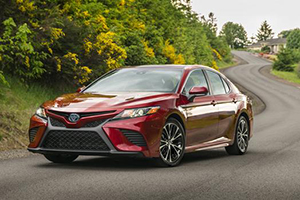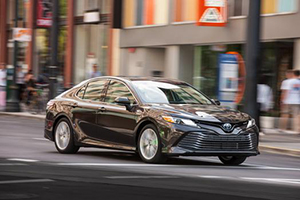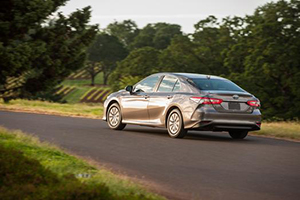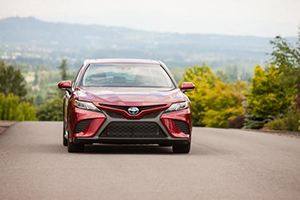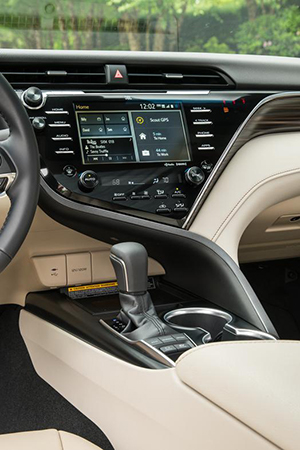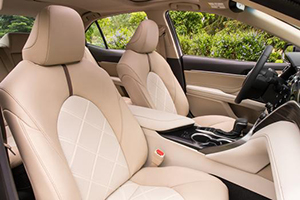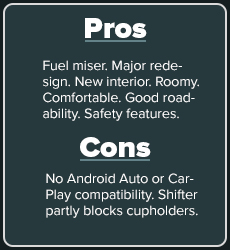2018 Toyota Camry Hybrid
The redesigned 2018 Toyota
Camry Hybrid gets a major redesign.
Prices: $27,800-$32,250
The Toyota Camry, which debuted in Japan in 1982 as a sensible, boring
family car, has been the best-selling auto in America for the last 15
years. But it’s never caused any excitement bells to ring.
Well, welcome to the redone 2018 Camry, which I tested in gas-electric
hybrid form. This eighth-generation car looks more aggressive. It is
longer, lower and wider than its predecessor, with a sleeker profile,
but a lowered hood and belt line don’t cause adult occupants
to feel like they’re sitting too deeply to see decently out
of windows.
The new Camry Hybrid mid-size front-drive sedan arrives in time to
battle its main rival: the redone 2018 Honda Accord, which also comes
as a hybrid. Of course, both the Camry and Accord have regular
gas-engine models.
The new Camry Hybrid has a slightly higher horsepower hybrid
powertrain. It delivers 208 horsepower for the base LE, mid-range SE
and top-range XLE, which I tested. Performance was good both in the
city and on highways. Merging into fast freeway traffic was no problem.
The Hybrid’s powertrain works with a smooth continuously
variable automatic transmission (CVT) that “mimics”
a quick-shifting six-speed automatic via a console-mounted shift lever
for the LE and XLE and paddle shifters for the S version. However, the
CVT emits a soft drone during lively acceleration. And I
didn’t notice much difference when the car was set in
“eco” “normal” or
“sport” modes, at least on the Chicago
area’s flat roads. I just left the car in
“eco” mode most of the time.
Sparkling estimated fuel economy is 51 m.p.g. city and 53 highway for
the LE model and 44 city and 47 highway for both the SE and XLE. I did
mostly in-town driving, with a good number of stop signs and little
open freeway motoring, so the car’s estimated fuel economy
was 32 m.p.g. Still, after 40 or so miles of driving, the fuel gauge
needle didn’t budge. More steady state highway cruising miles
doubtlessly would have considerably brought up the fuel economy
numbers. Only 87-octane fuel is needed.
List prices are $27,800 for the LE, $29,500 for the SE and $32,250 for
the XLE.
Standard for the XLE are leather-trimmed front and rear seats, heated
power front seats, push-button start, cruise control, Entune premium
audio and 3-zone automatic temperature control. Sun visors swivel and
their mirrors can be lit. But the car lacks Android Auto and Apple
CarPlay compatibility.
Safety features include forward-collision warning with automatic
braking and pedestrian protection, lane-departure alert, ten air bags
and a blind-spot monitor with rear cross-traffic alert. Options
included a “bird’s eye-view” camera to
detect objects around the entire car, a power tilt/slide moonroof with
a cover and a more elaborate Entune audio package.
All doors open wide for easy entry, and there’s plenty of
room for four tall occupants and a large trunk with a low, wide
opening. Even the soft center of the backseat is OK for a center rear
occupant, but it’s best left to the fold-down armrest with
dual cup holders. Split rear seat backs flip forward and sit flat for
more cargo space, although the opening from the trunk to the backseat
area is only moderately large. Doors open wide for easy entry, and
there are a good number of cabin storage areas.
The XLE’s interior was fairly upscale, with a fair amount of
soft-touch and premium materials. The easily grasped thick
leather-trimmed steering wheel has audio, Bluetooth phone and voice
command controls. The redesigned, quieter cockpit has gauges angled
toward the driver, an easily used touch screen and handy cup holders. A
good number of manual dashboard controls allow the driver to avoid
using the touch screen too much.
The power front seats are comfortable, but could use more side support
in curves. But then, this is primarily a family car, so it’s
not expected that many owners will zoom around curves with it.
However, the Camry Hybrid’s firm steering was precise, and my
test car stayed flat in curves taken at above-average speeds. Thank the
car’s lower center of gravity, new high-rigidity TNGA (Toyota
New Global Architecture) platform and change from a strut-type rear
suspension to a double wishbone style multi-link setup. Also helping my
test car feel confident were low-profile 45-series tires on fairly
large 18-inch wheels and vehicle stability and traction controls.
The supple ride was firmer than I anticipated it would be for the
top-line Camry Hybrid, but wasn’t uncomfortable. At least the
old Camry’s somewhat lazy ride motions were gone. And the
anti-lock brakes with a brake-assist feature had a natural brake feel
despite the hybrid system’s regenerative braking.
This Toyota long has been a proven, safe, dependable car. The new
Hybrid version provides a sexier look and more enjoyable driving
experience while retaining the Camry’s reliable operation.
